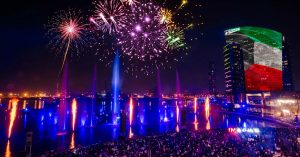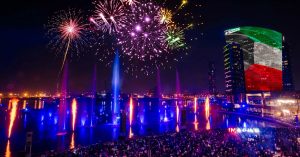Okay, so picture this. You’re in Dubai, land of shiny skyscrapers, massive malls, and the occasional camel crossing the road (yep, it still happens). Most people think “luxury shopping” or “desert safaris” when they hear Dubai. But what if I told you there’s a place here where art, culture, and creativity are the stars of the show? That’s Alserkal Avenue.
Tucked away in the industrial Al Quoz district, Alserkal Avenue is nothing like the polished glamour of Downtown Dubai. Instead, it’s raw, edgy, and buzzing with creative energy. Think old warehouses turned into galleries, concrete spaces transformed into performance stages, and cafés where you overhear artists debating their next installation.
So, let’s take a deep dive into this creative hub, its history, what you’ll find there, why it matters, and of course, how you can experience it yourself. Ready?

History and Background
Alright, quick rewind. Back in the mid-2000s, Dubai was booming, Burj Khalifa was on the rise, malls were popping up, and the city was positioning itself as the “center of the world.” But on the cultural side? Things were… well, pretty sparse. Sure, there were some galleries scattered around, but nothing that tied together a creative community.
Enter Abdelmonem Bin Eisa Alserkal, a visionary Emirati businessman with a soft spot for the arts. Around 2007, he looked at a bunch of warehouses in the Al Quoz industrial area and thought, “Why not turn this into something bigger?” What was once a zone for mechanics and storage started to morph into a haven for creativity.
- The early days (2008): The first gallery to set up shop was Ayyam Gallery. That move sent a clear signal, this wasn’t just another warehouse block, it was the seed of something cultural.
- Expansion (2015): By then, Alserkal Avenue had doubled in size to over 500,000 square feet of creative space. That’s half a million square feet of art, design, and culture sitting in what used to be a gritty industrial area.
- Today: The avenue is home to more than 60 spaces including galleries, cultural foundations, performance venues, and funky cafés.
One thing we love? The space never hides its industrial roots. The warehouses are still warehouses. You’ll see exposed beams, metal shutters, and big open concrete halls. Instead of pretending to be “fancy,” Alserkal Avenue wears its raw vibe with pride.
Can you imagine telling someone in 2007, “Hey, one day these dusty warehouses are going to host cutting-edge art shows and international festivals”? They’d laugh. But fast forward, and here we are.
Art Galleries and Exhibitions
So, what’s the first thing you notice when you step into Alserkal Avenue? The galleries. They’re everywhere. And not the stiff, intimidating type. The vibe is approachable, you can stroll in, chat with curators, or just wander around without feeling like you need a PhD in art history.
Here’s a quick look at some of the key players:
- Ayyam Gallery – The OG that started it all. Founded in Damascus, it now showcases Middle Eastern contemporary art with a strong global presence.
- Carbon 12 – Known for its bold exhibitions of international artists. If you’re into contemporary, conceptual stuff, this is your spot.
- The Third Line – A major gallery championing Middle Eastern talent. Artists like Hassan Hajjaj and Farah Al Qasimi have shown here.
- Green Art Gallery – Another heavyweight. It’s been around since the 1990s and focuses on artists from the Middle East, North Africa, and South Asia.
- Leila Heller Gallery – This one’s huge, a New York export that deals with major international names.
And then there’s Concrete, which deserves its own shout-out. Designed by the starchitects at OMA (Rem Koolhaas’s firm), Concrete opened in 2017 as the first building of its kind in the UAE. It’s a flexible space with sliding walls, high ceilings, and a minimalist industrial look. Vogue Arabia even called it “a blank canvas for creativity.”
To give you an idea of scale: within the Alserkal cluster, there are around 25 galleries and art spaces you can explore in one walk. That’s like doing a world art tour without leaving one block.
And exhibitions aren’t just local. The Avenue has hosted shows in collaboration with the Victoria and Albert Museum (London) and the Serpentine Galleries. Yep, we’re talking global standards right here in Dubai.
What’s fun is that exhibits change all the time. So you could go in April and see an immersive video installation, then return in September to find a photography retrospective. Keeps you on your toes.
Cultural and Creative Spaces
Now, here’s the thing about Alserkal Avenue, it’s not just art galleries. If it were, it’d still be cool, but what makes it truly special is the mix. You’ll find:
- Theatres, studios, concept stores, and co-working hubs — plus even independent bookshops scattered around. It’s like the universe conspired to put all things creative in one industrial block.
- Alserkal Arts Foundation – runs artist residencies, public art commissions, and education programs. Artists from around the world spend months here creating and connecting. Imagine sipping coffee next to someone who just exhibited in Berlin or São Paulo!
- Smaller studios – photographers, designers, and musicians working out of converted warehouses.
- The Junction – a black-box theatre where independent groups stage plays, comedy nights, and experimental performances. (Visit Dubai)
- Open doors policy – during special events, you can walk into studios, chat with artists, and see works-in-progress. It breaks down that scary wall between “artist” and “audience.”
- Not just high-brow art – design showcases, fashion pop-ups, vinyl record shops, and quirky home décor spots add to the creative mix.
Cafés and Dining Options
Now, let’s talk food. Because no cultural exploration is complete without some good bites, right? And honestly, Alserkal Avenue nails this.
Here are a few of the most popular foodie hangouts inside the Avenue:
- Wild & The Moon – A plant-based café that’s all about organic, gluten-free, and dairy-free goodies. Their smoothies and cold-pressed juices are perfect if you need a healthy pick-me-up.
- Nightjar Coffee Roasters – If you’re a coffee snob (no shame, me too), this place is heaven. They roast their beans in-house and serve everything from nitro cold brew to fancy pour-overs.
- Project Chaiwala – This one’s fun. It serves traditional Indian-style chai but in a cool, modern setting. Their karak tea with samosas is perfect fuel between gallery visits.
- Nappa Dori – Technically a design store, but they also have a café with artisan sandwiches and desserts.
- Gnaw – A newcomer known for funky bites and a chill vibe.
And here’s a cool stat: according to Dubai Tourism, cafés and dining in cultural hubs like Alserkal Avenue are seeing steady growth in footfall because they attract not only art lovers but also young professionals looking for a laid-back place to hang out.
Food here feels different from the mall experience. You’re not surrounded by luxury chains or food courts. Instead, you’re sitting in repurposed industrial spaces with murals on the wall, sipping coffee next to artists sketching in their notebooks. The vibe is part of the meal.
Events and Programs
Okay, this is where Alserkal Avenue really shines. The place is alive with events year-round, and they’re not just random, they’re curated to spark conversations and bring communities together.
Here are some of the big ones:
- Quoz Arts Fest: The superstar festival. Launched in 2012, it’s grown into one of Dubai’s largest arts and culture gatherings. In 2022 alone, it pulled in over 40,000 visitors in two days with nearly 200 activations — everything from art exhibitions and installations to music performances and food pop-ups. Can you imagine? Forty thousand people in a warehouse district for art and music. Love it.
- Alserkal Lates: A seasonal evening event where galleries stay open late, artists host talks, and the whole Avenue buzzes like a night market but for culture. It usually happens twice a year (spring and fall).
- Alserkal Art Week: Packed with exhibitions, panel discussions, and performances, this event turns the Avenue into a serious international art hub.
- Workshops & Talks: Throughout the year, you’ll find small-scale stuff like printmaking classes, film screenings, or sustainability talks. The idea is to keep people learning and engaging, not just consuming art.
And it’s not just art folks who show up. Families come with kids, foodies drop by for the cafés, and tourists who stumble across it often say it was the “hidden gem” of their trip.I’ll give you one more number to chew on: according to, the Avenue now houses over 70 contemporary concepts, from galleries to community spaces, and its events attract tens of thousands annually. That’s not small that’s a cultural movement in action.
Visitor Information
Alright, let’s get practical. How do you actually visit Alserkal Avenue without getting lost in Al Quoz’s industrial maze?
Location & Getting There
- Alserkal Avenue sits right in the Al Quoz industrial district, between Sheikh Zayed Road and Al Khail Road.
- The closest metro stop is Noor Bank Station (Red Line). From there, it’s about a 10-minute taxi ride. Honestly, most people just take a cab directly, it’s easier.
- If you’re driving, good news: parking is free and usually plentiful, which is a blessing in Dubai.
Opening Hours
- Most galleries open from 10:00 AM to 7:00 PM (Sunday–Saturday, though some close on Fridays).
- Cafés usually open earlier, around 8:00 AM for the coffee lovers.
- During festivals or “Lates” nights, spaces stay open until 10:00 PM or even later.
Entry Fees
- Here’s the best part: entry is free to most galleries and exhibitions. You just walk in.
- Some special installations, film screenings, or theatre shows may have a ticket, but we’re talking AED 50–100 max ($13–27). Pretty affordable compared to other Dubai entertainment.
Tips for Visitors
- Wear comfy shoes. You’ll be walking from warehouse to warehouse.
- Check the calendar. The Avenue has a packed events schedule, so it’s worth syncing your visit with an exhibition opening or a festival.
- Best time to go? Late afternoon into evening. You can catch some daylight for photos, then enjoy the buzz as the cafés fill up and the sun sets.
- Bring a friend. The whole vibe is conversational — you’ll want someone to discuss the art with (or laugh with when you don’t “get” that one abstract installation).
Why Visit Alserkal Avenue?
So, why should you swap a mall trip or beach day for a walk through an industrial art district? Here’s what makes Alserkal Avenue stand out:
- It’s real, raw Dubai.
Forget marble floors and chandeliers. This is creativity growing out of concrete warehouses. You get to see the city’s artistic side in its most authentic form. - It’s a community, not just a venue.
You’re not just looking at art on walls, you’re part of conversations, workshops, even chance encounters with artists and curators. - It’s global yet local.
You’ll see work from international heavyweights alongside emerging Emirati and regional artists. That mix is rare and refreshing. - It’s constantly evolving.
New galleries pop up, cafés change menus, artists rotate shows. Every visit feels different. - It’s Instagram-worthy.
Okay, not the deepest reason, but let’s be honest: the Avenue’s mix of industrial backdrops, murals, and installations makes for killer photos.
When people say “Dubai has no soul,” I always point them here. Spend an evening at Alserkal, and you’ll change your mind.
Alserkal Avenue in a Global Context
Now, if you’ve traveled a bit, you might be thinking: this sounds a lot like Wynwood Walls in Miami, 798 Art Zone in Beijing, or Shoreditch in London. And you’d be right, Alserkal Avenue is Dubai’s answer to those cultural hubs.
- Like 798 Art Zone in Beijing, it grew out of repurposed industrial warehouses.
- Like Wynwood in Miami, it combines art, food, and nightlife into one creative ecosystem.
- Like Shoreditch in London, it attracts young, edgy crowds who love street culture and experimental art.
But here’s what’s unique: Alserkal Avenue is right in the Middle East, a region where contemporary art is still carving its space. It’s become a platform for regional voices — from Syrian painters to Emirati photographers, while still pulling in global collaborations.
The Avenue’s impact hasn’t gone unnoticed. In 2017, Concrete was shortlisted for the Aga Khan Award for Architecture, a huge deal in the design world. (Aga Khan Award) That kind of recognition shows how Alserkal isn’t just a local hotspot but a global player.
The Future of Alserkal Avenue
Dubai has big ambitions for culture. The city’s Dubai Culture & Arts Authority launched the Dubai Creative Economy Strategy 2025, aiming to double the contribution of creative industries to the UAE’s GDP. (Dubai Culture)
Alserkal Avenue is central to that vision. It’s not just a place to see art — it’s a hub for innovation, sustainability, and community building. Expect more residencies, international partnerships, and probably even larger cultural festivals in the years ahead.
Honestly, if you visit now, you’ll get bragging rights. You’ll be able to say, “I saw Alserkal back when it was still this cool hidden gem,” before it grows into something even bigger.
Conclusion
So, there you have it, a full tour of Alserkal Avenue. From its humble warehouse beginnings to becoming one of the Middle East’s leading art hubs, it’s a story of vision, grit, and community.
You get galleries that rival global heavyweights, cafés that make you want to linger, events that pack in tens of thousands, and a vibe that’s just… different from anywhere else in Dubai.
If you’re into art, you’ll fall in love. If you’re not into art, you’ll still find yourself enjoying the food, people-watching, and energy. It’s the kind of place that sneaks up on you and leaves you inspired.
Next time you’re in Dubai, skip the extra mall visit and give Alserkal Avenue a shot. Trust me, you’ll walk away thinking, “Wait, that was Dubai?”





